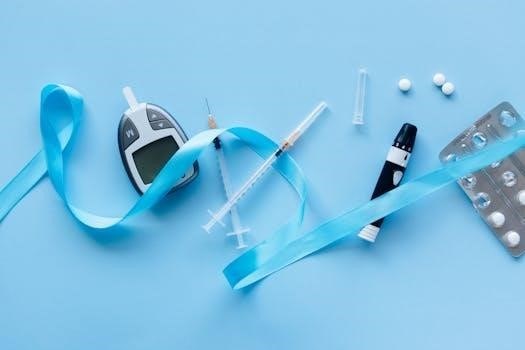Managing diabetes effectively involves consistently monitoring blood sugar levels. A weekly PDF blood sugar log sheet is a valuable tool, offering a structured way to record readings and identify patterns. This free, printable resource aids in understanding how diet, activity, and medication impact glucose levels.
Understanding Blood Sugar Logging for Diabetes Management
Effective diabetes management hinges on consistent blood sugar monitoring, a practice made simpler with tools like a weekly blood sugar log sheet. Understanding why and how to log your blood sugar levels is paramount for maintaining optimal health. Logging provides a clear picture of your glucose trends, allowing you and your healthcare provider to make informed decisions regarding medication, diet, and exercise.
Regular recording of blood glucose levels helps identify patterns and potential triggers for hyperglycemia (high blood sugar) or hypoglycemia (low blood sugar). These logs help you track the impact of meals, physical activity, stress, and medications on your blood sugar. Moreover, by reviewing these records, healthcare professionals can tailor treatment plans to your individual needs, potentially preventing long-term complications like vision loss, kidney damage, and cardiovascular issues.
Whether using a free printable PDF or a digital tracker, the key is to maintain a consistent and accurate log. This proactive approach empowers you to take control of your diabetes and improve your overall well-being.
Importance of Monitoring Blood Sugar Levels
Monitoring blood sugar levels is paramount for individuals with diabetes, serving as the cornerstone of effective diabetes management. Regular monitoring provides invaluable insights into how various factors, such as food intake, physical activity, medication, and stress, influence blood glucose levels; This information empowers individuals to make informed decisions about their daily routines and adjust their treatment plans accordingly, in consultation with their healthcare providers.
Consistent monitoring helps identify patterns and trends in blood sugar fluctuations, enabling early detection of potential problems, such as hyperglycemia (high blood sugar) or hypoglycemia (low blood sugar). Timely intervention can prevent or mitigate the severity of these episodes, reducing the risk of short-term complications like fatigue, confusion, or even loss of consciousness. Moreover, effective blood sugar control can significantly lower the risk of long-term complications associated with diabetes, including nerve damage, kidney disease, vision loss, and cardiovascular problems.
Utilizing tools like a weekly blood sugar log sheet facilitates structured monitoring, ensuring that readings are accurately recorded and easily accessible for review. This proactive approach fosters a sense of control and empowers individuals to actively participate in managing their diabetes and improving their overall health outcomes.
Benefits of Using a Blood Sugar Log Sheet
Employing a blood sugar log sheet offers numerous advantages for individuals managing diabetes. Primarily, it provides a structured and organized method for recording blood glucose readings, making it easier to track fluctuations and identify patterns over time. This detailed record serves as a valuable tool for both the individual and their healthcare provider, facilitating informed decision-making regarding treatment adjustments.
A log sheet promotes a comprehensive understanding of how various factors impact blood sugar levels. By recording not only glucose readings but also information on meals, medication dosages, physical activity, and stress levels, individuals can correlate these elements with their blood sugar responses. This insight empowers them to make lifestyle modifications, such as dietary changes or exercise adjustments, to better manage their condition.
Furthermore, a well-maintained log sheet enhances communication with healthcare professionals. During appointments, the log sheet provides a clear and concise overview of blood sugar control, enabling more effective discussions about treatment plans and potential adjustments. This collaborative approach leads to better outcomes and improved overall health management for individuals with diabetes. The availability of free, printable log sheets makes this beneficial tool accessible to everyone.

Features of a Weekly Blood Sugar Log Sheet
A typical weekly blood sugar log sheet includes sections for recording glucose levels at different times, medication details, and notes on diet and activity. Customizable templates are often available to suit individual needs.
Key Components to Track
Effectively managing blood sugar levels requires consistent monitoring and detailed record-keeping. A well-designed blood sugar log sheet should include several key components to provide a comprehensive overview of your glucose levels and related factors.
Firstly, tracking blood glucose readings at various times of the day is crucial. This includes fasting levels, pre-meal readings, post-meal readings, and bedtime levels. Recording these values allows you to identify patterns and trends, helping you understand how different meals and activities affect your blood sugar.
Secondly, the log sheet should have space to document insulin dosages and other medications taken. Note the type of medication, the dosage, and the time it was administered. This information is essential for correlating medication intake with blood sugar fluctuations.
Finally, it’s beneficial to include a section for notes on diet, physical activity, and stress levels. Record what you ate, the amount of exercise you engaged in, and any significant stressors experienced. These factors can significantly impact blood sugar levels, and tracking them provides valuable context.
Customizable Templates and Design Options
When selecting a weekly blood sugar log sheet, consider the benefits of customizable templates and design options. A personalized log sheet can enhance your monitoring experience, making it more efficient and tailored to your specific needs.
Customizable templates allow you to modify the layout, add or remove sections, and adjust the font size and style. This flexibility ensures that the log sheet fits your individual tracking preferences and accommodates any specific information your healthcare provider recommends monitoring.
Design options can also play a significant role in the usability of the log sheet. Choose a design that is easy to read and visually appealing. Consider factors such as color schemes, spacing, and the arrangement of data fields. A well-designed log sheet can make it easier to record and interpret your blood sugar levels.
Additionally, some templates offer options for tracking additional health metrics, such as blood pressure, weight, or carbohydrate intake. This comprehensive approach can provide a more holistic view of your health and aid in better diabetes management.
Availability in PDF, PNG, and JPG Formats
The versatility of a weekly blood sugar log sheet is greatly enhanced by its availability in multiple formats, including PDF, PNG, and JPG. Each format offers distinct advantages, catering to various user preferences and technical requirements.
PDF (Portable Document Format) is widely recognized for its universal compatibility and ability to preserve formatting across different devices and operating systems. This makes it an ideal choice for printing and sharing log sheets without worrying about layout inconsistencies.
PNG (Portable Network Graphics) and JPG (Joint Photographic Experts Group) formats are image-based, providing flexibility in terms of editing and integration into digital documents. PNG is particularly suitable for log sheets with graphics and text, as it preserves image quality without compression artifacts.
JPG, on the other hand, is a compressed format that reduces file size, making it convenient for online sharing and storage. However, it may not be the best option for log sheets with fine details, as compression can sometimes lead to a loss of clarity.
The availability of these formats ensures that you can choose the one that best suits your needs and technical capabilities.

Finding and Downloading Free Printable Log Sheets
Numerous online resources offer free, printable weekly blood sugar log sheets. These templates are readily accessible, allowing individuals to easily download and utilize them for effective diabetes management and blood sugar tracking.
Online Resources Offering Free Templates
Several online platforms provide free, printable blood sugar log sheet templates, catering to diverse needs and preferences for managing diabetes. Websites like diabetes.org and UMMHealth offer resources, including log sheets, to aid individuals in tracking their blood glucose levels effectively. Many other sites provide customizable templates in PDF, PNG, or JPG formats, allowing users to personalize their logs.
These resources often include weekly and monthly log options, enabling individuals to choose a timeframe that suits their monitoring style. Some templates also offer space to record insulin dosages, medications, diet, activity, and stress levels, providing a comprehensive overview of factors influencing blood sugar. The availability of these free templates online simplifies the process of blood sugar monitoring, empowering individuals with diabetes to actively manage their health and well-being by tracking daily patterns.
These user-friendly templates are easily accessible and printable from home.
Weekly vs. Monthly Log Sheets
When managing blood sugar, choosing between weekly and monthly log sheets depends on individual monitoring needs and preferences. Weekly log sheets offer a detailed, day-by-day view of blood glucose levels, ideal for those requiring close monitoring or experiencing frequent fluctuations. This format allows for quicker identification of patterns and immediate adjustments to diet, medication, or activity levels.
Monthly log sheets, conversely, provide a broader overview, suitable for individuals with stable blood sugar levels who prefer a less granular approach. This format simplifies data collection and reduces the frequency of recording, offering a convenient option for long-term trend analysis. The choice between weekly and monthly logs should align with the individual’s diabetes management plan and consultation with a healthcare professional, ensuring the selected format effectively supports their health goals and lifestyle.
Both formats facilitate pattern recognition and informed decision-making regarding diabetes care.
Printing and Using the Log Sheet

Once you’ve downloaded your free printable blood sugar log sheet, printing it is straightforward. Ensure your printer is loaded with paper and select the “print” option within your PDF viewer. For optimal readability, choose a clear, high-resolution setting. After printing, using the log sheet effectively involves several key steps.
First, familiarize yourself with the log’s layout, noting spaces for dates, times, blood sugar readings, insulin dosages, and any relevant notes about meals, activity, or stress levels. Consistently record your blood sugar levels at the specified times each day, as determined by your healthcare provider. Be diligent in noting any factors that might influence your readings, such as food intake, exercise, or emotional state.
This comprehensive record will provide valuable insights into your diabetes management and facilitate informed discussions with your healthcare team, ultimately promoting better health outcomes and personalized care.

Using the Log Sheet Effectively
Effective use involves consistent recording of blood glucose levels at various times, tracking insulin and medications, and noting diet, activity, and stress. This detailed record aids in identifying patterns and improving diabetes management.
Recording Blood Glucose Levels at Different Times
Accurately recording blood glucose levels at different times is paramount for effective diabetes management. A comprehensive log should include readings taken before meals, two hours after meals, before bedtime, and during the night, if recommended by your healthcare provider. This detailed approach helps to understand how food intake affects blood sugar levels throughout the day.
Consistency in timing is crucial; try to measure your blood sugar at the same times each day. This regularity allows for more accurate pattern recognition and informed adjustments to your diet, medication, or activity levels. Note any deviations from your normal routine, such as changes in meal times or exercise schedules, as these can impact your readings.
Using a weekly blood sugar log sheet, clearly mark the time of each reading alongside the corresponding glucose level. This organized approach facilitates the identification of trends and helps you and your healthcare team make well-informed decisions about your diabetes care plan. Remember, accurate and consistent data is the key to successful blood sugar management.
Tracking Insulin Dosage and Medications
Accurate tracking of insulin dosage and other medications is vital for individuals managing diabetes. Consistently recording the type and amount of insulin or medication taken, alongside blood glucose readings, provides a comprehensive view of treatment effectiveness. Note the time of administration to correlate it with changes in blood sugar levels.
A detailed log should include information about both basal and bolus insulin, or any oral medications, listing the dosage and specific medication name. This enables healthcare providers to identify patterns and make informed adjustments to your treatment plan. Include any changes in medication or dosage, and consult with your doctor before making any modifications.
Using a weekly blood sugar log sheet, create a dedicated section for recording insulin dosage and medications. Clearly differentiate between different types of insulin or medications and note the timing of administration. This meticulous tracking helps to optimize medication schedules and ensure that you are receiving the appropriate treatment for your individual needs, promoting better blood sugar control and overall health.
Adding Notes on Diet, Activity, and Stress
To gain a holistic understanding of blood sugar fluctuations, it’s crucial to record dietary intake, physical activity, and stress levels alongside glucose readings. Documenting meals, including carbohydrate content, helps identify how different foods impact blood sugar. Note the timing and intensity of physical activity, as exercise can significantly affect glucose levels. Stress can also influence blood sugar, so recording stressful events or periods is essential.
In your weekly blood sugar log sheet, create a dedicated space for these notes. Be specific about the types and quantities of food consumed, the duration and intensity of exercise, and the nature and severity of stressful events. This detailed information allows you and your healthcare provider to identify patterns and make informed decisions about lifestyle adjustments.
Consistent tracking of diet, activity, and stress, along with blood sugar levels, provides a comprehensive picture of your diabetes management. By understanding how these factors interact, you can better control your blood sugar, prevent complications, and improve your overall well-being. This holistic approach empowers you to take an active role in managing your health.
